RELG 433 - Biblical Archaeology
Course Notes
The Chalcolithic Period in Israel - ca. 4,300 BC - 3,300 BC
Images in the text are linked to larger photos - click on them to see the larger pictures.
Hover the mouse over the images to see their captions and copyright credits.
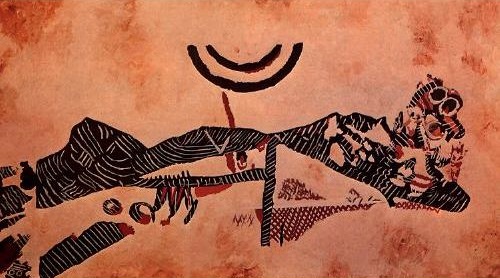

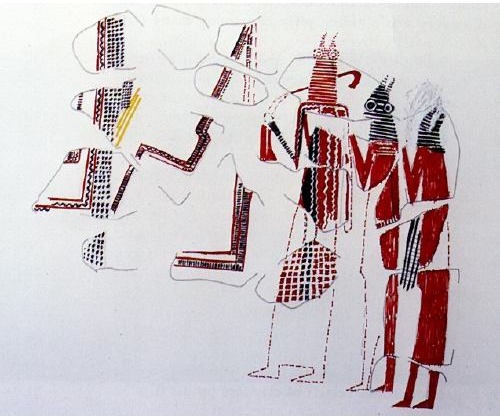
 In Israel/Palestine the predominant culture was the Ghassulian, named for the type site at Teleilat Ghassul in the Jordanian hills across the river Jordan from Jericho.
In Israel/Palestine the predominant culture was the Ghassulian, named for the type site at Teleilat Ghassul in the Jordanian hills across the river Jordan from Jericho.
The houses at Teleilat Ghassul are remarkable for their wall paintings - the walls were covered with white plaster, then painted with red and black.
Settlements showed some degree of planning. They were unfortified villages, typically with twenty to fifty dwelling units in a village.
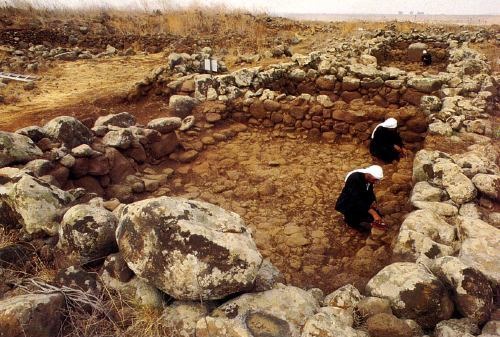
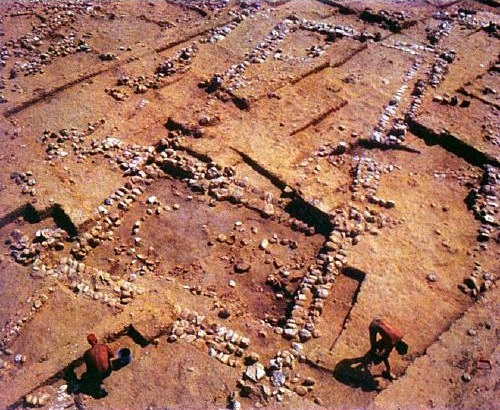 The groups of dwellings were built closely together forming streets. The houses were rectangular, sometimes linked together to form chains of dwellings. They were usually broad houses - with an entry in the center of one of the long walls. They often had a cultic niche with a small statue in the wall facing the entrance. The walls were built of boulders and field stones, and floors were paved with large stone slabs. Houses often had a courtyard and probable animal pens.
The groups of dwellings were built closely together forming streets. The houses were rectangular, sometimes linked together to form chains of dwellings. They were usually broad houses - with an entry in the center of one of the long walls. They often had a cultic niche with a small statue in the wall facing the entrance. The walls were built of boulders and field stones, and floors were paved with large stone slabs. Houses often had a courtyard and probable animal pens.
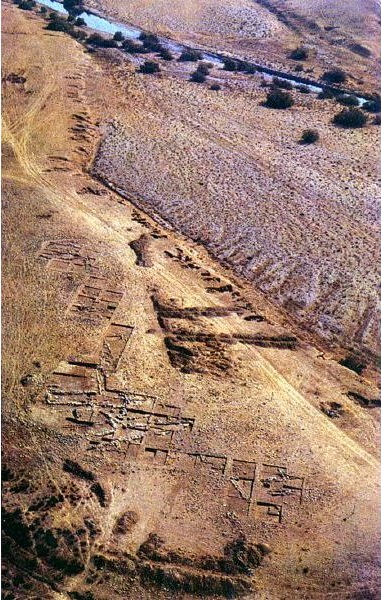

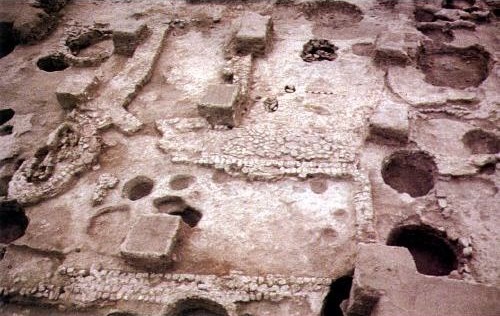
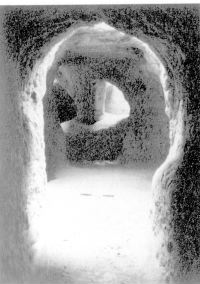 In the region around the Beer Sheba valley, where the climate is hot and dry, and the stone is soft enough to dig into, people lived in underground burrows dug into the earth. This included Beersheba, Shiqmim, Bir Safadi, Gilat, and Bir Matar.
In the region around the Beer Sheba valley, where the climate is hot and dry, and the stone is soft enough to dig into, people lived in underground burrows dug into the earth. This included Beersheba, Shiqmim, Bir Safadi, Gilat, and Bir Matar.
A structure that is believed to be a shrine is set on a plateau above the wadi at En Gedi.
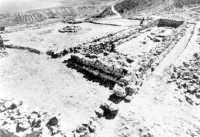

 It was based on a Broad Room, with a "Holy of Holies", and evidence of animal sacrifices. No dwellings were found in the near vicinity, so it is thought that this was a religious gathering-place for the semi-nomadic pastoralists of the Judean desert. Amihai Mazar is of the opinion that the copper objects found in the 'Cave of the Treasure' at Nahal Mishmar may have come from the shrine at En Gedi.
It was based on a Broad Room, with a "Holy of Holies", and evidence of animal sacrifices. No dwellings were found in the near vicinity, so it is thought that this was a religious gathering-place for the semi-nomadic pastoralists of the Judean desert. Amihai Mazar is of the opinion that the copper objects found in the 'Cave of the Treasure' at Nahal Mishmar may have come from the shrine at En Gedi.
![]()
Copper Industry :
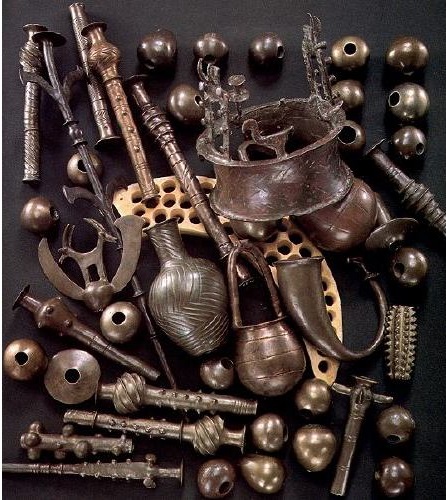
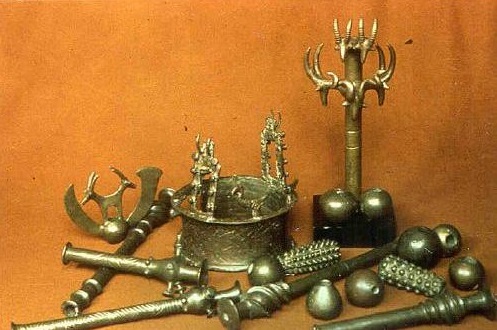
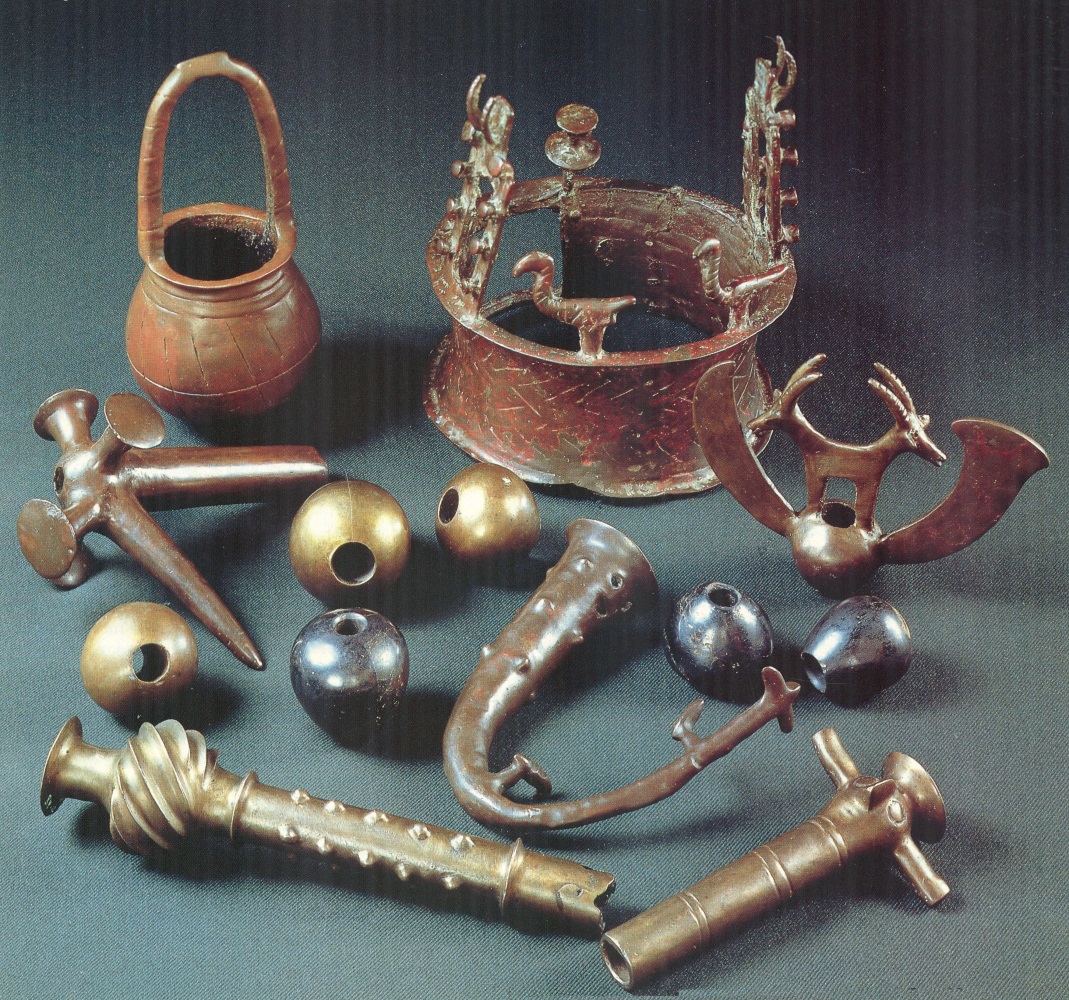


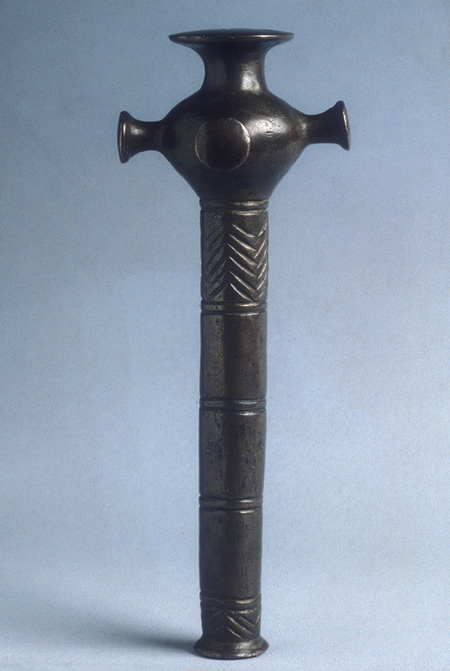 The production of copper objects marks the break between the Neolithic and Chalcolithic periods
The production of copper objects marks the break between the Neolithic and Chalcolithic periods
The Nahal Mishmar Treasure was found in a cave near En Gedi. It consists of 436 copper ritual objects, including crowns and scepters, which were wrapped in a mat.
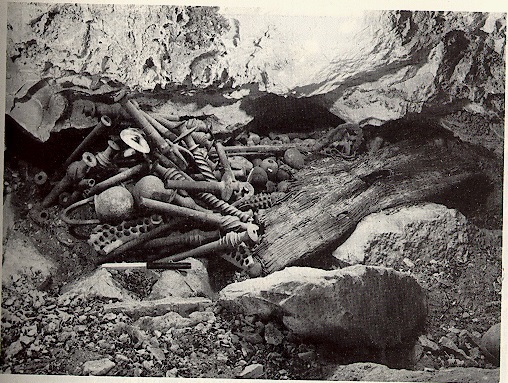 They were accompanied by ivory objects, linen and woolen textiles, parts of a weaving loom, loom weights, part of a sandal, and basketry - mats, baskets, ropes, and a sieve. Remains of food were also found.
They were accompanied by ivory objects, linen and woolen textiles, parts of a weaving loom, loom weights, part of a sandal, and basketry - mats, baskets, ropes, and a sieve. Remains of food were also found.
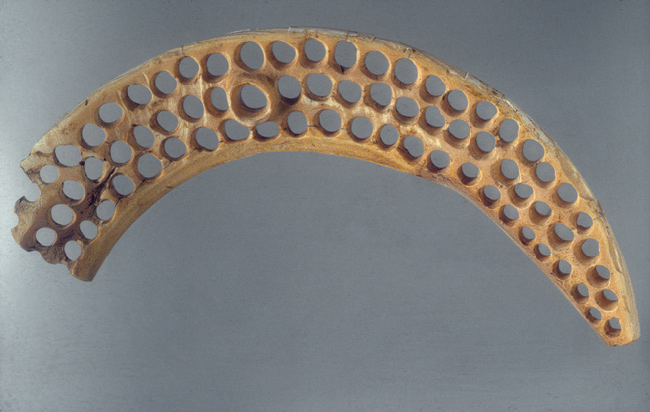 The copper of the Mishmar treasure was not local, nor from the Arabah, nor from Cyprus, but probably from Armenia. It contains enough arsenic to strengthen the copper.
The copper of the Mishmar treasure was not local, nor from the Arabah, nor from Cyprus, but probably from Armenia. It contains enough arsenic to strengthen the copper.
The questions remains as to whether or not the hoard was associated with the "temple" at En Gedi.
The objects were produced by the "Lost Wax" technique, in which one makes a model of the object in wax and packs it in a container and fills the container with sand or clay. The copper is heated until it melts, then poured into the mold, the wax melts and runs out, and the copper fills the hole in the sand. The wax is lost in the process.
There is also evidence for copper industry near Beersheba, making similar objects.
![]()
Pottery
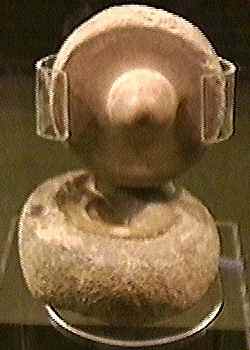 was generally made by hand, though the first evidence for a simple potter's wheel has also been found. The wheel was turned by hand, not by foot. Large pots were still made by hand, built up on a woven mat for ease of manipulation.
Lug handles are typical of the pottery of this period. Decoration might consist of ropes of clay, painted red bands, or smaller painted geometric designs.
was generally made by hand, though the first evidence for a simple potter's wheel has also been found. The wheel was turned by hand, not by foot. Large pots were still made by hand, built up on a woven mat for ease of manipulation.
Lug handles are typical of the pottery of this period. Decoration might consist of ropes of clay, painted red bands, or smaller painted geometric designs.
There were various types of pottery :
- cult stands - the term generally used for what Mazar describes as bowls with a high fenestrated foot. These are associated with probable religious offerings of incense or small sacrifices. The "high fenestrated foot" looks like a pillar with windows
-
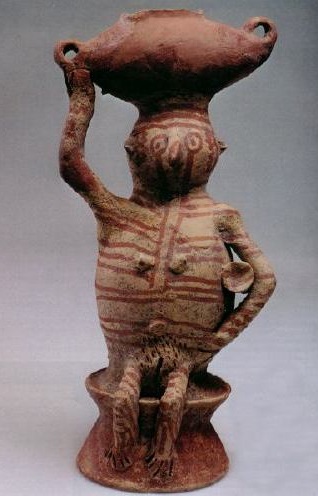 "churns" were originally thought to be intended for churning milk into butter - but can you imagine getting your hand into one of those, to get the butter out when it had formed? To my mind the figure from Gilat illustrates the use of this type of vessel - it was probably not used for churning milk to butter, but for carrying liquids on the head. Remember, horses, donkeys, and camels had not yet been domesticated, so everything had to be carried by people. In cultures without draft animals burdens are carried on the head even today - and for that, one needs an object with a low center of gravity for good balance - ie. the object should be low and wide, which is exactly how these vessels are shaped, even with loop handles for holding them steady.
"churns" were originally thought to be intended for churning milk into butter - but can you imagine getting your hand into one of those, to get the butter out when it had formed? To my mind the figure from Gilat illustrates the use of this type of vessel - it was probably not used for churning milk to butter, but for carrying liquids on the head. Remember, horses, donkeys, and camels had not yet been domesticated, so everything had to be carried by people. In cultures without draft animals burdens are carried on the head even today - and for that, one needs an object with a low center of gravity for good balance - ie. the object should be low and wide, which is exactly how these vessels are shaped, even with loop handles for holding them steady. - cornets - look like an ice-cream cone, and are found particularly at Teleilat Ghassul
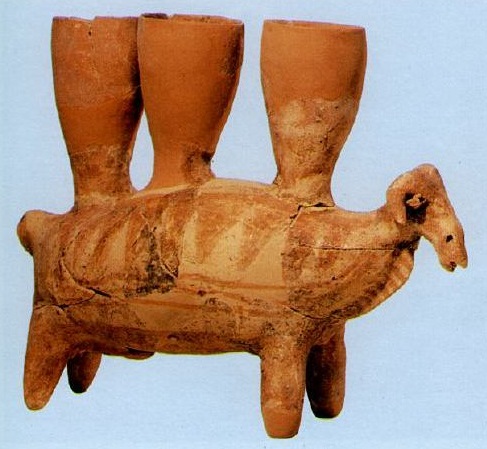
- kraters - bowl-shaped vessels
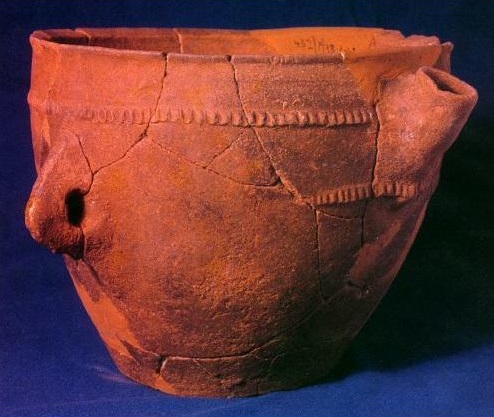
- large storage jars, called "pithoi" (singular - pithos)
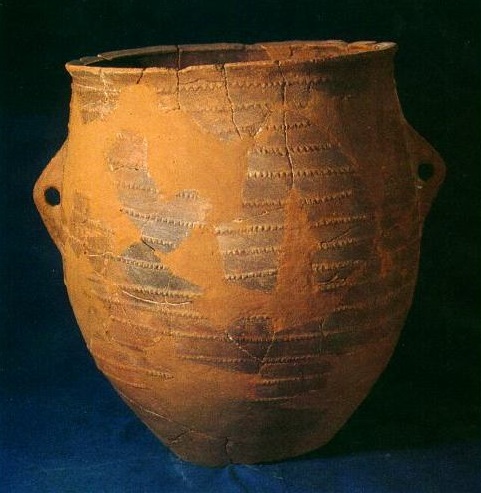
- smaller closed vessels
Understanding the sketches of pottery :
An archaeologist's sketch of a pot typically shows both the outside of the pot and a cut-away section through the pot. The left-hand side of the illustration shows the outside, with its decorations, and the right-hand side shows a section through the pot, and sometimes also the decorations on the inside
During this period, people were still making implements of flint, stone, and bone.
There was also a trade in stones and stone objects between various regions : flint or obsidian was brought from Anatolia (what is now west Turkey); hematite from the Sinai, and shells from the Mediterranean.
Flint implements included axes, adzes, flat scrapers, borers, awls, sickles used for agriculture, leather work, harvesting
Stone - black basalt bowls, from the Golan area, were traded as far as Beersheba.
![]()
Agriculture :
There is evidence that a wide variety of crops and trees was cultivated.
Olive trees yielded olive oil, used for cooking and for oil lamps.
Date palms, particularly from Mesopotamian sites, were probably first cultivated during this period.
The cultivation of wheat, barley, lentils, garlic, and onions continued.
Flax was cultivated for the production and weaving of linen.
Pomegranates and nuts were found - they were probably cultivated, but possibly harvested from wild trees.
Acorns were gathered from wild Oak trees - they could be chewed, roasted, or ground to give a flour and used in cooking.
There is also evidence for trade in agricultural products between various regions.
Domesticated animals : there is evidence for herds of sheep, goats, and some cattle and pigs.
![]()
Religion and Ritual :
Ritual / Cultic Objects included :
- The wall-paintings at Teleilat Ghassul - painted in red/white/black on plastered walls
- The 'Treasure' of Nahal Mishmar included copper "crowns" and "scepters"
-

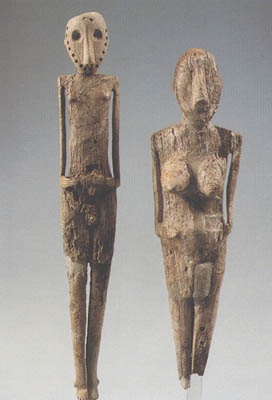 Carved ivory figures from Beersheba and the surrounding region, where not only figures, but also ivory parings and carving tools were found. The Ivory might have been local hippopotamus ivory, or elephant ivory from Africa or Syria. There are some similarities in style with Egyptian and Mesopotamian cultures. They are sometimes referred to as "goddesses", though they might be 'magical' or votive figures.
Carved ivory figures from Beersheba and the surrounding region, where not only figures, but also ivory parings and carving tools were found. The Ivory might have been local hippopotamus ivory, or elephant ivory from Africa or Syria. There are some similarities in style with Egyptian and Mesopotamian cultures. They are sometimes referred to as "goddesses", though they might be 'magical' or votive figures. -
 Violin figures are stylized female torsos, similar to earlier artifacts from Anatolia, Crete, and the Cyclades.
Violin figures are stylized female torsos, similar to earlier artifacts from Anatolia, Crete, and the Cyclades. -
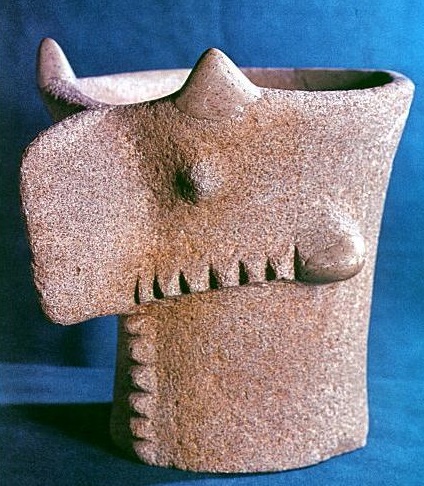
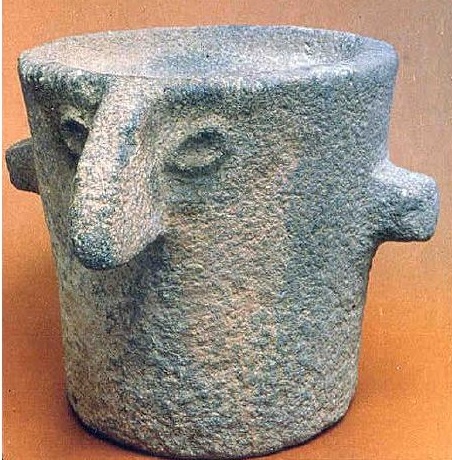 Cylindrical basalt blocks from the Golan - they were often shaped like heads, with a depression on top which might have been for incense or other offerings.
Cylindrical basalt blocks from the Golan - they were often shaped like heads, with a depression on top which might have been for incense or other offerings. -
 Ossuaries - for containing someone's bones. They were shaped like houses, and probably indicate a belief in an afterlife.
Ossuaries - for containing someone's bones. They were shaped like houses, and probably indicate a belief in an afterlife.
Burials - During this period we have the first appearance in Israel/Palestine of burials outside a settlement.
Burial methods :
-
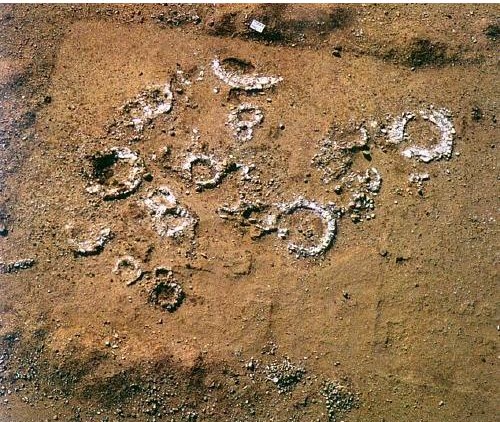 Built up tombs found at Shiqmim and Sinai, with rounded or circular walls, containing several disarticulated skeletons of adults and children.
Built up tombs found at Shiqmim and Sinai, with rounded or circular walls, containing several disarticulated skeletons of adults and children. -
 Pottery Ossuaries - shaped like houses, and put in caves rather than being kept in the dwelling or under its floor, as in the Neolithic periods.
Pottery Ossuaries - shaped like houses, and put in caves rather than being kept in the dwelling or under its floor, as in the Neolithic periods. - Dolmen - a pile of large stone slabs, with a stone slab over the top.
- Tumulus - a circular cairn of stones, sometimes covered with dirt.
- Cist Graves - a hole in the ground for putting bones in after the body had decomposed.
Burial Terms :
- Articulated - the bones of the skeleton are still joined together - the body was buried whole.
- Disarticulated - the bones of the skeleton were separated from one another and then buried.
- Primary Burial - the body was buried and left there.
- Secondary Burial - the body may have been buried, or exposed until only bones were left. The remains were then buried or put in an ossuary.
- Ossuary - container for bones.
- Transhumance - moving a body from one grave to another - it was exhumed and reburied. This might have been done if a tribe was moving from one place to another.
![]()
The origins and fate of Ghassulian culture :
The Ghassulian culture may have grown locally out of PN (Pottery Neolithic). At Teleilat Ghassul the first Ghassulain strata develop from PN levels.
It may represent new peoples moving into the area from Egypt (there is evidence of trade with Egypt) and/or Syria (there are some similarities, but the pottery is different.)
It may be a combination of newcomers who knew how to work copper, moving in and settling into an established community.
The Ghassulian culture ended ca. 3300 BC
Centers were abandoned. The En Gedi shrine was emptied out and closed up. The treasures were hidden in the Nahal Mishmar cave. But there is no evidence of violence.
Did Bronze Age cultures push out or take over? But they did not settle in the same sites as Ghassulian.
Was there an Egyptian invasion? deportation of the people to Egypt? - Egypt was becoming an organized entity with a dynasty of rulers.
Drought? Famine? Epidemic? At present there is no clear answer.
Copyright © 2020 Shirley J. Rollinson, all Rights Reserved